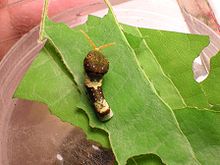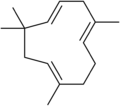Terpene

Terpenes (
Terpenes are classified by the number of carbons:
The one terpene that has major applications is natural rubber (i.e., polyisoprene). The possibility that other terpenes could be used as precursors to produce synthetic polymers has been investigated. Many terpenes have been shown to have pharmacological effects. Terpenes are also components of some traditional medicines, such as aromatherapy, and as active ingredients of pesticides in agriculture. [4]
History and terminology
The term terpene was coined in 1866 by the German chemist August Kekulé to denote all hydrocarbons having the empirical formula C10H16, of which camphene was one. Previously, many hydrocarbons having the empirical formula C10H16 had been called "camphene", but many other hydrocarbons of the same composition had had different names. Kekulé coined the term "terpene" in order to reduce the confusion.[5][6] The name "terpene" is a shortened form of "terpentine", an obsolete spelling of "turpentine".[7]
Although sometimes used interchangeably with "terpenes",
The 1939
Biological function
Terpenes are major biosynthetic building blocks.
Higher amounts of terpenes are released by trees in warmer weather,[17] where they may function as a natural mechanism of cloud seeding. The clouds reflect sunlight, allowing the forest temperature to regulate.[18]
Some insects use some terpenes as a form of defense. For example, termites of the subfamily Nasutitermitinae ward off predatory insects through the use of a specialized mechanism called a fontanellar gun, which ejects a resinous mixture of terpenes.[19]
Applications

The one terpene that has major applications is
Some form hydroperoxides that are valued as catalysts in the production of polymers.Many terpenes have been shown to have pharmacological effects, although most studies are from laboratory research, and clinical research in humans is preliminary.[23] Terpenes are also components of some traditional medicines, such as aromatherapy.[24]
Reflecting their defensive role in plants, terpenes are used as active ingredients of pesticides in agriculture.[25]

Physical and chemical properties
Terpenes are colorless, although impure samples are often yellow. Boiling points scale with molecular size: terpenes, sesquiterpenes, and diterpenes respectively at 110, 160, and 220 °C. Being highly non-polar, they are insoluble in water. Being hydrocarbons, they are highly flammable and have low specific gravity (float on water). They are tactilely light oils considerably less viscous than familiar vegetable oils like corn oil (28 cP), with viscosity ranging from 1 cP (à la water) to 6 cP. Terpenes are local irritants and can cause gastrointestinal disturbances if ingested.
Terpenoids (mono-, sesqui-, di-, etc.) have similar physical properties but tend to be more polar and hence slightly more soluble in water and somewhat less volatile than their terpene analogues. Highly polar derivatives of terpenoids are the
Biosynthesis
Isoprene as the building block
Conceptually derived from isoprenes, the structures and formulas of terpenes follow the biogenetic isoprene rule or the C5 rule, as described in 1953 by Leopold Ružička[26] and colleagues.[27] The C5 isoprene units are provided in the form of dimethylallyl pyrophosphate (DMAPP) and isopentenyl pyrophosphate (IPP). DMAPP and IPP are structural isomers to each other. This pair of building blocks are produced by two distinct metabolic pathways: the mevalonate (MVA) pathway and the non-mevalonate (MEP) pathway. These two pathways are mutually exclusive in most organisms, except for some bacteria and land plants.[citation needed] In general, most archaea and eukaryotes use the MVA pathway, while bacteria mostly have the MEP pathway. IPP and DMAPP are final products of both MVA and MEP pathways and the relative abundance of these two isoprene units is enzymatically regulated in host organisms.
| Organism | Pathways |
|---|---|
| Bacteria | MVA or MEP |
| Archaea | MVA |
| Green Algae | MEP |
| Plants | MVA and MEP |
| Animals | MVA |
Fungi |
MVA |
Mevalonate pathway
This pathway conjugates three molecules of
The mevalonate (MVA) pathway is distributed in all three domains of life; archaea, bacteria and eukaryotes. The MVA pathway is universally distributed in archaea and non-photosynthetic eukaryotes, while the pathway is sparse in bacteria. In photosynthetic eukaryotes, some species possess the MVA pathway, while others have the MEP pathway or both MVA and MEP pathways. This is due to the acquisition of the MEP pathway by a common ancestor of Archaeplastida (algae + land plants) through the endosymbiosis of ancestral cyanobacteria that possessed the MEP pathway. The MVA and MEP pathways were selectively lost in individual photosynthetic lineages.
Also, the archaeal MVA pathway is not completely homologous to the eukaryotic MVA pathway.[28] Instead, the eukaryotic MVA pathway is closer to the bacterial MVA pathway.
Non-mevalonate pathway
The non-mevalonate pathway or the 2-C-methyl-D-erythritol 4-phosphate (MEP) pathway starts with
C5 IPP and C5 DMAPP are the end-products in either pathway and are the precursors of terpenoids with various carbon numbers (typically C5 to C40), side chains of (bacterio)chlorophylls, hemes and quinones. Synthesis of all higher terpenoids proceeds via formation of geranyl pyrophosphate (GPP), farnesyl pyrophosphate (FPP), and geranylgeranyl pyrophosphate (GGPP).
Geranyl pyrophosphate phase and beyond

In both MVA and MEP pathways, IPP is isomerized to DMAPP by the enzyme isopentenyl pyrophosphate isomerase. IPP and DMAPP condense to give geranyl pyrophosphate, the precursor to monoterpenes and monoterpenoids.
Geranyl pyrophosphate is also converted to farnesyl pyrophosphate and geranylgeranyl pyrophosphate, respectively C15 and C20 precursors to sesquiterpenes and diterpenes (as well as sesequiterpenoids and diterpenoids).[2] Biosynthesis is mediated by terpene synthase.[29][30]
Terpenes to terpenoids
The genomes of many plant species contain genes that encode terpenoid synthase enzymes imparting terpenes with their basic structure, and cytochrome P450s that modify this basic structure.[2][31]
Structure
Terpenes can be visualized as the result of linking isoprene (C5H8) units "head to tail" to form chains and rings.[32] A few terpenes are linked “tail to tail”, and larger branched terpenes may be linked “tail to mid”.
Formula
Strictly speaking all monoterpenes have the same chemical formula C10H16. Similarly all sesquiterpenes and diterpenes have formulas of C15H24 and C20H32 respectively. The structural diversity of mono-, sesqui-, and diterpenes is a consequence of isomerism.
Chirality
Terpenes and terpenoids are usually
Unsaturation
Most terpenes and terpenoids feature C=C groups, i.e. they exhibit unsaturation. Since they carry no functional groups aside from their unsaturation, terpenes are structurally distinctive. The unsaturation is associated with di- and trisubstituted
Classification
- Selected terpenes
-
Limonene, a monoterpene.
-
Carvone is a monoterpenoid, a modified monoterpene.
-
Pinene, a monoterpene which exists as two isomers, is a major consistituent of turpentine.
-
Hinokitiol is a monoterpenoid, a tropolone derivative.
-
taxol, an anticancer agent.
-
Geosmin is a sesquiterpenoid.
Terpenes may be classified by the number of isoprene units in the molecule; a prefix in the name indicates the number of isoprene pairs needed to assemble the molecule. Commonly, terpenes contain 2, 3, 4 or 6 isoprene units; the tetraterpenes (8 isoprene units) form a separate class of compounds called carotenoids; the others are rare.
- The basic unit isoprene itself is a hemiterpene. It may form oxygen-containing derivatives such as isovaleric acidanalogous to terpenoids.
- .
- Sesquiterpenes consist of three isoprene units and have the molecular formula C15H24. Examples of sesquiterpenes and sesquiterpenoids include humulene, farnesenes, farnesol, geosmin.[34](The sesqui- prefix means one and a half.)
- .
- Sesterterpenes, terpenes having 25 carbons and five isoprene units, are rare relative to the other sizes. (The sester- prefix means two and a half.) An example of a sesterterpenoid is geranylfarnesol.
- Triterpenes consist of six isoprene units and have the molecular formula C30H48. The linear triterpene squalene, the major constituent of shark liver oil, is derived from the reductive coupling of two molecules of farnesyl pyrophosphate. Squalene is then processed biosynthetically to generate either lanosterol or cycloartenol, the structural precursors to all the steroids.
- Sesquarterpenes are composed of seven isoprene units and have the molecular formula C35H56. Sesquarterpenes are typically microbial in their origin. Examples of sesquarterpenoids are ferrugicadiol and tetraprenylcurcumene.
- beta-carotenes.
- Polyterpenes consist of long chains of many isoprene units. Natural rubber consists of polyisoprene in which the double bonds are cis. Some plants produce a polyisoprene with trans double bonds, known as gutta-percha.
- Norisoprenoids, characterized by the shortening of a chain or ring by the removal of a methylene group or substitution of one or more methyl side chains by hydrogen atoms. These include the C13-norisoprenoid 3-oxo-α-ionol present in glycosidases.[39]

Industrial syntheses
While terpenes and terpenoids occur widely, their extraction from natural sources is often problematic. Consequently, they are produced by chemical synthesis, usually from

References
- ^ ISBN 9783527609949.
- ^ )
- ^ "What are Terpenes". rareterpenes.com. 13 April 2021.
- ISBN 978-0-618-73063-6.
- ^ Kekulé, August (1866). Lehrbuch der organischen Chemie [Textbook of Organic Chemistry] (in German). Vol. 2. Erlangen, (Germany): Ferdinand Enke. pp. 464–465.
From pp. 464–465: "Mit dem Namen Terpene bezeichnen wir … unter verschiedenen Namen aufgeführt werden." (By the name "terpene" we designate in general the hydrocarbons composed according to the [empirical] formula C10H16 (see §. 1540)
- ^ Dev, Sukh (1989). "Chapter 8. Isoprenoids: 8.1. Terpenoids.". In Rowe, John W. (ed.). Natural Products of Woody Plants: Chemicals Extraneous to the Lignocellulosic Cell Wall. Berlin and Heidelberg, Germany: Springer-Verlag. pp. 691–807. ; see p. 691.
- ^ ISBN 978-3527306732.
- )
- S2CID 4312428.
- nobelprize.org. Nobel Foundation. 1939. Retrieved 6 July 2017.
- ^ "The Nobel Prize in Chemistry 1939".
- PMID 31051473.
- S2CID 21443154.
- PMID 12857838.
- PMID 16469917.
- PMID 17576426.
- ^ "An Introduction to Terpenes".
- ^ Adam, David (October 31, 2008). "Scientists discover cloud-thickening chemicals in trees that could offer a new weapon in the fight against global warming". The Guardian.
- .
- ISBN 9780080453163.
- ^ Roberts, Maddy Shaw (22 January 2019). "What the heck is rosin – and why do violinists need it?". Classic FM. Retrieved 22 July 2022.
- PMID 25442616.
- PMID 25429661.
- PMID 32106479.
- S2CID 39469817.
- S2CID 44195550.
- .
- PMID 30224495.
- PMID 29017925.
- PMID 27462341.
- PMID 25502595.
- S2CID 44195550.
- ISBN 978-3527317868.
- ^ ISBN 9780128021040.
- ISBN 978-0-8412-3729-2.
- S2CID 101007887.
- PMID 19828152.
- PMID 19817422.
- .
External links
- Terpenes at the U.S. National Library of Medicine Medical Subject Headings (MeSH)
- Pope, Frank George (1911). . In Chisholm, Hugh (ed.). Encyclopædia Britannica. Vol. 26 (11th ed.). Cambridge University Press. pp. 647–652. Survey of terpene chemistry.






